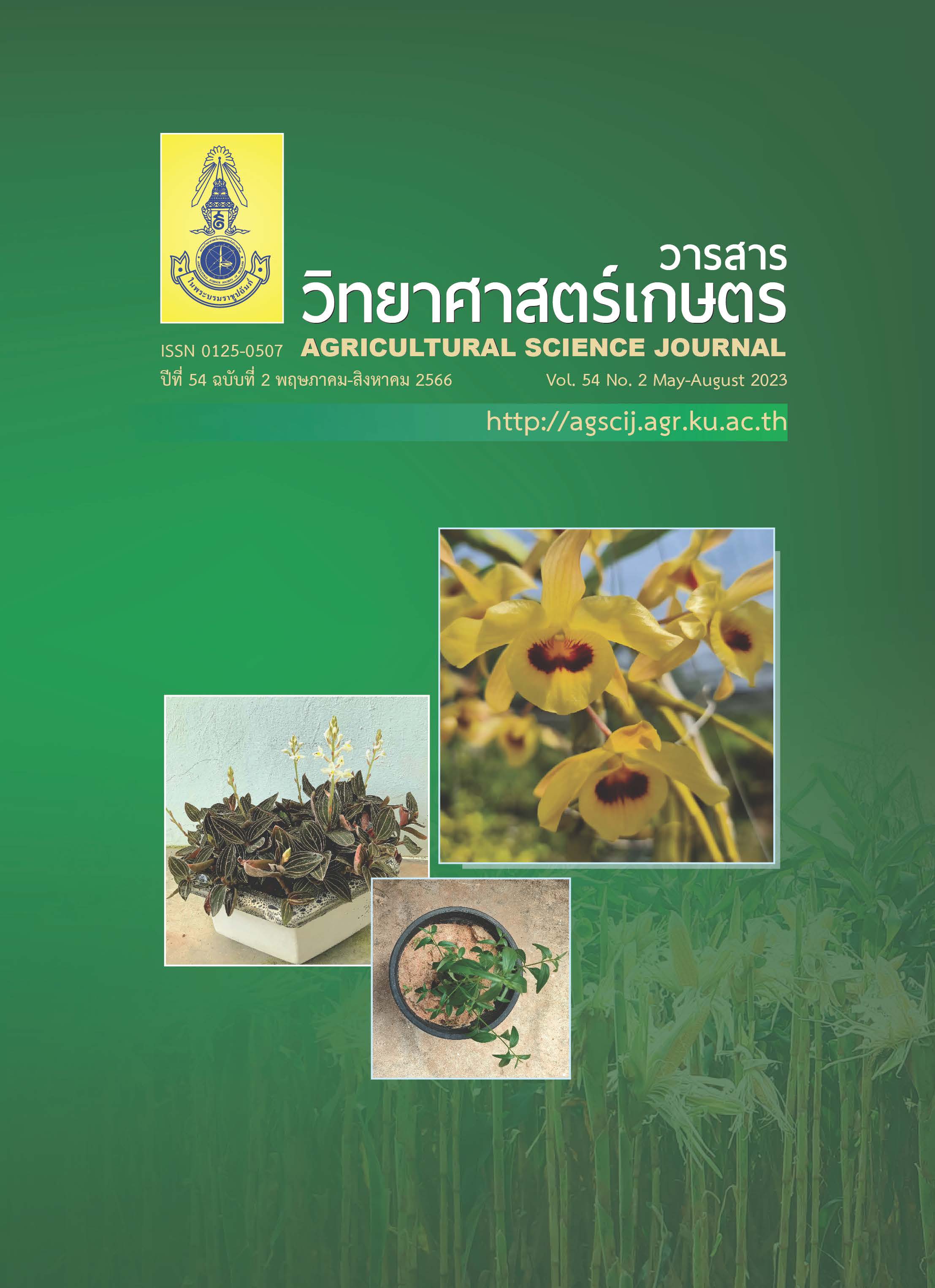ผลของสารกำจัดวัชพืชประเภทก่อนงอกร่วมกับหลังงอกต่อการควบคุมวัชพืช การเจริญเติบโต และผลผลิตของข้าวโพด
Main Article Content
บทคัดย่อ
ความเป็นมาและวัตถุุประสงค์: การใช้สารป้องกันกำจัดวัชพืชที่เหมาะสมกับข้าวโพดช่วยลดความเป็นพิษต่อข้าวโพด และสนับสนุนให้ข้าวโพดเจริญเติบโตได้อย่างสมบูรณ์ งานวิจัยนี้มีวัตถุประสงค์เพื่อทดสอบการใช้สารกำจัดวัชพืชประเภทก่อนงอกร่วมกับหลังงอกที่มีประสิทธิภาพในการควบคุมวัชพืชในข้าวโพดไร่สายพันธุ์แท้และข้าวโพดไร่ลูกผสม
วิธีดำเนินการวิจัย: วางแผนการทดลองแบบสปลิตพล็อตในแผนแบบบล็อกสมบูรณ์เชิงสุ่ม จำนวน 3 ซ้ำ ปัจจัยหลัก 7 ทรีตเมนต์ ได้แก่ การใช้สารกำจัดวัชพืชก่อนงอก atrazine + pendimethalin เพียงอย่างเดียว เปรียบเทียบกับการใช้สารกำจัดวัชพืชก่อนงอกร่วมกับสารกำจัดวัชพืชหลังงอก 6 ทรีตเมนต์ ได้แก่ 2,4-D dimethylammonium, glufosinate ammonium, nicosulfuron + atrazine, topramezone + atrazine, tembotrione + atrazine, และ mesotrione/atrazine ปัจจัยรอง ได้แก่ ข้าวโพดไร่สายพันธุ์แท้ของมหาวิทยาลัยเกษตรศาสตร์ จำนวน 18 สายพันธุ์ และข้าวโพดไร่ลูกผสม (พันธุ์ SW4452, NS3, S7328, PAC339, CP888 และ DK6919) ซึ่งถูกใช้เป็นพันธุ์เปรียบเทียบ
ผลการวิจัย: การใช้สารกำจัดวัชพืชก่อนงอกร่วมกับสารกำจัดวัชพืชหลังงอก 2,4-D dimethylammonium ส่งผลให้ใบในส่วนยอดแสดงอาการหงิกงอในข้าวโพดไร่สายพันธุ์แท้ Ki48, Ki60 และ Ki61 การใช้สารกำจัดวัชพืชหลังงอก glufosinate ammonium เป็นพิษรุนแรงต่อข้าวโพดในทุกสายพันธุ์ ส่วนสารกำจัดวัชพืช nicosulfuron + atrazine มีประสิทธิภาพในการควบคุมวัชพืชได้ดีที่สุด ที่ 30 วันหลังพ่นสาร สามารถควบคุมวัชพืชได้มากกว่า 80 เปอร์เซ็นต์ (P < 0.05) แต่กลับมีผลกระทบรุนแรงต่อการเจริญเติบโตและผลผลิตของข้าวโพดสายพันธุ์ Ki48, Ki50, Ki53, Ki56, Ki57, Ki58, Ki61, Ki63 และ Ki64
สรุป: การใช้ topramezone + atrazine, tembotrione + atrazine และ mesotrione/atrazine มีประสิทธิภาพในการควบคุมวัชพืชได้ดีและให้ผลผลิตข้าวโพดไม่แตกต่างกันอย่างมีนัยสำคัญ (P > 0.05)
Article Details

อนุญาตภายใต้เงื่อนไข Creative Commons Attribution-NonCommercial-NoDerivatives 4.0 International License.
เอกสารอ้างอิง
Bryan, T. 1977. Research Method in Weed Science. Southern Weed Science Society, Auburn, Alabama.
Changsaluk, S., S. Rungmekarat, N. Waramitr, R. Suwanmonkha and S. Lim-a-roon. 2016. Weed control with fluroxypyr in field corn plantation in Lopburi province, pp. 423–429. In Proc. the 54th Kasetsart University Annual Conference: Plants, Animals, Veterinary Medicine, Fisheries, Agricultural Extension and Home Economics, 2–5 February 2016. (in Thai)
Changsaluk, S., S. Rungmekarat, S. Srichomporn, P. Phocadate, S. Jampathong and R. Suwanmonkha. 2019. Effect of nicosulfuron to pre-commercial field corn hybrids and inbred lines. In Proc. the 14th National Plant Protection Conference, 12–14 November 2019. (in Thai)
da Silva, A.F., L. Galon, G. Concenco, I. Aspiazu, E.A. Ferreira, S.P. Tironi and A.A. da Silva. 2014. Sugarcane cultivars present differential susceptibility to herbicides ametryn and trifloxysulfuron-sodium. Aust. J. Crop Sci. 8(6): 965–972.
Department of Agriculture. 2009. Manual of Herbicides. Plant Protection Research and Development Office, Bangkok. (in Thai)
Giraldeli, A.L., G.Z. da Silva, A.F.M. Silva, G.A. Ghirardello, L.R. de Marco and R.V. Filho. 2019. Efficacy and selectivity of alternative herbicides to glyphosate on maize. Rev. Ceres. 66(4): 279–286. https://doi.org/10.1590/0034-737X201966040006.
James, T.K., A. Rahman and J. Mellsop. 2000. Weed competition in maize crop under different timings for post-emergence weed control. N. Z. Plant Prot. 53: 269–272. https://doi.org/10.30843/nzpp.2000.53.3706.
Poonpaiboonpipat, T. and M. Wachoo. 2020. Efficacy of cartain herbicides on purple nutsedge control and their toxicity on sweet corn. Naresuan Agricultural Journal. 17(1): 48–57. (in Thai)
Pornprom, T. 2017. Herbicides: Principles and Mode of Action. Chulalongkorn University Press, Bangkok, Thailand. (in Thai)
Rungmekarat, S., P. Phocadate, U. Lertsuchartwanich, S. Changsaluk and J. Romkaew. 2021. Efficacy of pre-emergence in combination with post-emergence herbicides on weed control in maize. Khon Kaen Agr. J. 49(4): 903–914. https://doi.org/10.14456/kaj.2021.81. (in Thai)
Sardana, V., G. Mahajan, K. Jabran and B.S. Chauhan. 2017. Role of competition in managing weeds: an introduction to the special issue. Crop Prot. 95: 1–7. https://doi.org/10.1016/j.cropro.2016.09.011.
Sathuwijarn, S., S. Lapbanjop, S. Choekongjak, N. Wongsuwan and C. Maneechote. 2013. Efficiency of post-emergence herbicides for weed control in maize, pp. 167–181. In Research Repost 2013. Plant Protection Research and Development Office, Department of Agriculture, Bangkok, Thailand. (in Thai)
Senseman, S.A. 2007. Herbicide Handbook. 9th edition. Weed Science Society of America, USA.
Suwanketnikom, R. 2004. Herbicides: Basics and How to Use. Kasetsart University Press, Bangkok, Thailand. (in Thai)
Tesfay, A., M. Amin and N. Mulugeta. 2014. Management of weeds in maize (Zea mays L.) through various pre and post emergency herbicides. Adv. Crop Sci. Tech. 2(5): 151. https://doi.org/10.4172/2329-8863.1000151.
Weed Science Division. 2004. Manual of Weed Control and Herbicides. Weed Science Division, Plant Protection Research and Development Office, Department of Agriculture, Bangkok, Thailand. (in Thai)


